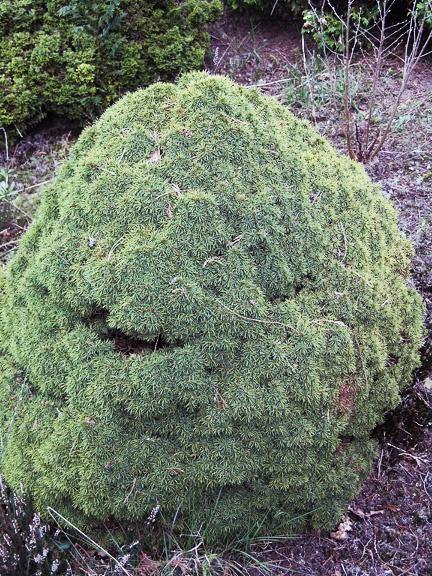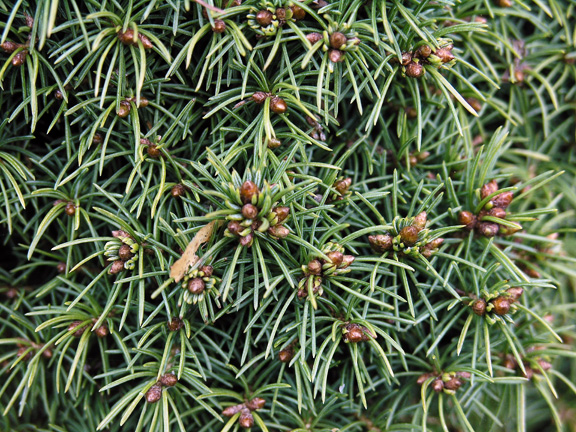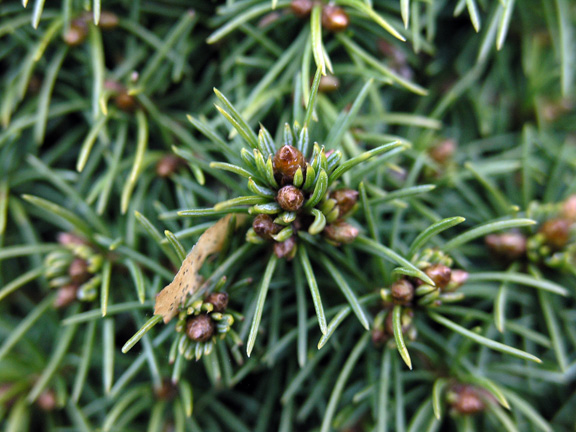| General Description | Slow growing dwarf, ball shaped evergreen shrub that requires little maintenance. Soft but rigid needles emerge light green, darkening with maturity. Brown buds, less than 1 cm, long form at the ends of branches, with bark appearing light grey-brown, thickening and forming scales as it ages. |
| ID Characteristic | Small, globose, dense shrub with compact branching; the foliage grows close to the ground; therefore, it does not require any facing plants. New growth emerges with a light green colour and becomes dark green with age. Needles are square and 5–8 cm long; brown buds form toward the ends of branches. |
| Shape | A globular shaped dwarf shrub with dense, broadly spreading branches that grow to the ground. |
| Landscape | This slow growing dwarf conifer is well suited for small garden spaces and rock gardens. It's small globose shape also makes this shrub a nice addition to flower beds and border planting. It can be used as a patio or container plant because it requires very little maintenance. With the foliage growing close to the ground this shrub does not require any facing plants. |
| Propagation | As a cultivar it can only be propagated by grafting semi-hardwood cuttings. Take cuttings in the winter by removing side shoots and pinching off bottom needles, graft under stock and keep the newly grafted plant moist and warm (18–20°C) by placing in a plastic filmed tent. After five or six weeks, the graft should form calluses, and can be removed from the warmed environment three months later. |
| Cultivation | Plant in full or partial shade in soil that is moist but well drained. Alkaline soil will yield the best growth but some acidity will be tolerated; slightly tolerant of urban pollution. Trim lightly to maintain shape and dense growth. |
| Pests | May be susceptible to aphids and conifer spider mites as well as adelgids gall. |
| Notable Specimens | University of Guelph Arboretum, Guelph, Ontario, Canada; St. Mary's Nursery, Winnipeg, Manitoba, Canada. |
| Habitat | Horticultural origin. |
| Bark/Stem Description | Bark emerges as grey-brown when young; as the shrub ages bark becomes thick and forms large scales. |
| Flower/Leaf Bud Description | Buds are brown and rigid; they are less than 1 cm. |
| Leaf Description | New growth is light, lime green, and darkens to a rich deep green as it ages. Needles are square, 5–8 cm long, growing in a whorled pattern from the stems. The needles are soft but rigid to the touch. |
| Flower Description | Not ornamentally significant. |
| Fruit Description | Fruit is born in small cones that are less than 1 cm long. They appear near the end of shoots in groups of three with a narrow shape and leathery texture. |
| Colour Description | Buds and cones are brown. New growth is light, lime green which darkens to a rich green as it matures. Bark is grey-brown. |
| Texture Description | Soft rigid needles are accompanied by rigid brown buds and scaly bark. Cones are small (less than 1 cm) and leathery. |


